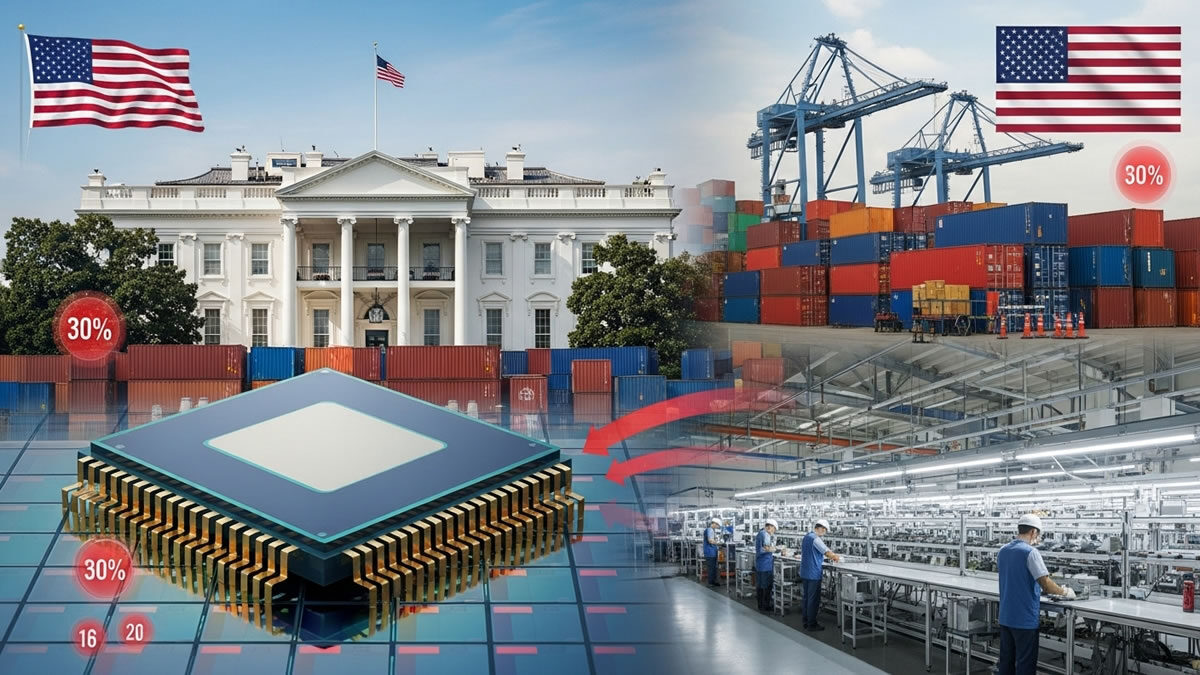The Trump administration is reportedly contemplating a proportion-oriented plan to enhance semiconductor manufacturing within the U.S., one that penalizes local producers with duties if goals aren’t achieved.
Policy Under Review
The administration is evaluating a strategy that would require U.S. semiconductor corporations to fabricate the same quantity of chips in the U.S. as their buyers obtain from foreign suppliers, the Wall Street Journal mentioned, citing unnamed informants.
Stay up to date with the latest technology in TheTechCrunch.info, which covers artificial intelligence, mobile and web apps, modern things, cyber security, and general technical news. From AI’s successes to chat and generative tools, such as smartphones, laptops, and wearables’ special reviews, TheTechCrunch gives an insight into this case.
Tariff Implications
Enterprises that fail to satisfy this 1:1 ratio will face levies, the article noted, though the schedule to realize this balance remains uncertain. President Donald Trump has been discussing enforcing duties on the semiconductor sector since the start of August.
Potential Outcomes
Such a proportion-centered approach would be uncommon if the administration hopes to accomplish its aim of returning semiconductor production domestically. It might ultimately encourage more national semiconductor creation, but it also risks damaging the U.S. chip market until manufacturing expands to handle the massive demand.
Manufacturing Challenges
Launching local chip fabrication plants is neither an easy nor a quick process. Intel’s Ohio facility, initially planned to begin operations this year, has been postponed several times and now targets an opening in 2030.
Industry Response
Meanwhile, Taiwan Semiconductor Manufacturing Company TSMC in March stated it is pledging $100 billion over the upcoming four years for establishing infrastructure to sustain chip manufacturing plants in the U.S., though it offered limited specifics.
Global Supply Chain Reconfiguration
The semiconductor industry depends on a long-term, globally distributed model where different areas have design, construction, assembly, and testing. Existing trade streams and pricing structures will be interrupted by the need for strict domestic production.
Partners in Asia and Europe can meet their investment strategies in response, and potentially lead to new alliances or countermeasures. This can reopen the global semiconductor landscape over the next decade and affect the development of innovation clusters.
Investment Incentives And Innovation Capacity
Economists claim that tariff rates alone are not sufficient to ensure a prosperous domestic chip area. They recommend a ratio-based mandate with tax credits, direct grants, training programs, and research funding. Without constant innovation on the state -Av -Art edge, American plants risk growing old by producing older generational chips instead of the oldest nodes.
The government can intensify successes in partnership materials, energy-efficient production, and packaging technologies between universities and private companies, leading to a global competitive ecosystem.
Workforce And Infrastructure Considerations
A special workforce is required for engineers, technicians, and support staff to produce and operate semiconductor fabs, as well as access to water, energy, and reliable logistics. US areas competing for these facilities should invest heavily in education, training, and infrastructure to attract and maintain skilled workers.
Otherwise, projects may meet delays or fail to reach the entire capacity even after construction. Extensive societal benefits with such investments include high-wage work and secondary development in the supplier industry.
Consumer Impact And Market Prices
Rapid changes to domestic production are likely to ripple through the pricing of consumer electronics. Smartphones, laptops, electric vehicles, and data centers are all dependent on advanced pieces. High production costs or limited offers mean an increase in prices for consumers, or a slower product can be released. Political decision makers hope that after an initial adjustment period, a safer domestic supply will stabilize basic prices and support the innovation instead of stipulating it.
National Security And Strategic Autonomy
Supporters of the proposed political frameworks are concerned as a matter of national security. With increasing geopolitical stresses, it is considered important to ensure a stable domestic supply of semi-circulators as they are essential for defense systems, significant infrastructure, and emergency reaction skills.
The United States from reduce its dependence on foreign producers can making it less vulnerable to battles, natural disasters, or disorders caused by political disputes. However, critics warn that overgrowth and protectionism can invite revenge and limit access to global markets.
Long-Term Outlook
Over the next few years, the success of this initiative will depend on how the government effectively balances coercion with support. If used carefully, it can jumpstart a new era of US semiconductor leadership and create thousands of high-skilled jobs.
If poorly done, it can charge companies with costs, provoke trade disputes, and slow technological progress. In the coming months will show how industry and decision makers are navigating this complex change and whether the benefits eventually take over the risk.
Explore a complete hub for the latest apps, smart things, and security updates online, ranging from AI-operated solutions and automation tools. TheTechCrunch.info offers in-depth articles, comparisons, and specialist analysis designed to understand the rapidly changing technology. Whether you are keen on robotics, data protection, or the latest digital trends.


